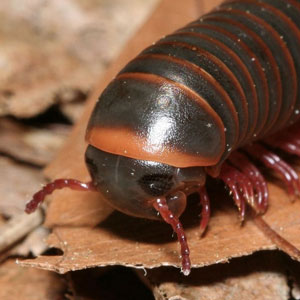Where Are Those Millipedes Coming From?
By Chris Williams on April 21, 2014.
 As an entomologist, I am often amused at how others describe pests. I was just talking to a man in Stoneham who was trying to describe “bugs” that he was finding on his back patio. He said they were wormlike with lots of little hairs on the bottom side. I soon realized that he was talking about millipedes and that the little hairs were the many legs of the millipedes. To the untrained and without a microscope, they do look more like hairs than legs. He wouldn’t expect them to be legs because, as he said, “these things barely move unless you poke at them.” Come to think of it, it is surprising that, with all those legs (15 to 45 pairs!), millipedes don’t move more quickly.
As an entomologist, I am often amused at how others describe pests. I was just talking to a man in Stoneham who was trying to describe “bugs” that he was finding on his back patio. He said they were wormlike with lots of little hairs on the bottom side. I soon realized that he was talking about millipedes and that the little hairs were the many legs of the millipedes. To the untrained and without a microscope, they do look more like hairs than legs. He wouldn’t expect them to be legs because, as he said, “these things barely move unless you poke at them.” Come to think of it, it is surprising that, with all those legs (15 to 45 pairs!), millipedes don’t move more quickly.
He was worried though because he was finding millipedes dead on his back slab porch, and he wanted to know how to control them. When I asked how many he was seeing daily, he said maybe 6; some days none. I told him he was lucky. Sometimes when millipedes migrate, they migrate by the thousands.
Millipedes are not insects; they are most closely related to centipedes. They are round in cross-section, dark in color, and can roll into a circle if threatened (that was the giveaway in my caller’s description). Millipedes normally live a pretty quiet life, hidden in damp areas with lots of decaying vegetation like under mulch, leaves, in grass clipping piles, or under logs or rocks (or patio slabs). We usually don’t notice them unless they get inside or unless there is a “millipede migration.”
Why Do Millipedes Migrate?
Millipede migrations happen when conditions in the millipedes’ outside world change, usually when it gets too wet or too dry. Maybe they’ve had a lot of rain in Stoneham lately. During their search for better conditions, millipedes can end up indoors if they find openings under doors or around foundations. Because they require high moisture, they usually end up in the dampest areas of your home, often on the lower level. You’ll find them around washing machines, sump pumps, floor drains, laundry sinks, and in garages. Even so, they don’t live long in the drier indoor air.
Millipede migrations are usually short-lived. In a couple of days, they will have disappeared. If you’re having recurring problems with millipedes, there are steps you can take to reduce their numbers around the outside of your home. Reducing mulch, dethatching lawns, watering lawns in the morning so they can dry, and removing foundation debris will cut down on millipedes. A pesticide perimeter treatment around the foundation of your home will also help eliminate millipedes and other pests before they can get inside. Give us a call and ask about our twice yearly exterior preventative service.
Photo credit: Foter / Creative Commons Attribution-ShareAlike 3.0 Unported (CC BY-SA 3.0)